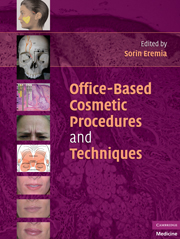Book contents
- Frontmatter
- Contents
- PREFACE
- CONTRIBUTORS
- PART ONE ANATOMY AND THE AGING PROCESS
- PART TWO ANESTHESIA AND SEDATION FOR OFFICE COSMETIC PROCEDURES
- PART THREE FILLERS AND NEUROTOXINS
- PART FOUR COSMETIC APPLICATIONS OF LIGHT, RADIOFREQUENCY, AND ULTRASOUND ENERGY
- Chap. 42 TREATMENT OF TELANGIECTASIA, POIKILODERMA, AND FACE AND LEG VEINS
- Chap. 43 VASCULAR LASERS
- Chap. 44 OVERVIEW OF CO2 AND ER:YAG LASERS AND PLASMA DEVICES
- Chap. 45 CONTEMPORARY CO2 LASER RESURFACING
- Chap. 46 ER:YAG
- Chap. 47 PLASMA SKIN REJUVENATION OF THE HANDS
- Chap. 48 NONABLATIVE LASER TISSUE REMODELING: 1,064-, 1,320-, 1,450-, AND 1,540-NM LASER SYSTEMS
- Chap. 49 OVERVIEW OF BROADBAND LIGHT DEVICES
- Chap. 50 TITAN: INDUCING DERMAL CONTRACTION
- Chap. 51 SCITON BROADBAND LIGHT AND ER:YAG MICROPEEL COMBINATION
- Chap. 52 AMINOLEVULINIC ACID PHOTODYNAMIC THERAPY FOR FACIAL REJUVENATION AND ACNE
- Chap. 53 THERMAGE FOR FACE AND BODY
- Chap. 54 LUMENIS ALUMA SKIN TIGHTENING SYSTEM
- Chap. 55 ELLMAN RADIOFREQUENCY DEVICE FOR SKIN TIGHTENING
- Chap. 56 ALMA ACCENT DUAL RADIOFREQUENCY DEVICE FOR TISSUE CONTOURING
- Chap. 57 COMBINED LIGHT AND BIPOLAR RADIOFREQUENCY
- Chap. 58 FRACTIONAL LASERS: GENERAL CONCEPTS
- Chap. 59 PALOMAR LUX 1,540-NM FRACTIONAL LASER
- Chap. 60 FRAXEL 1,550-NM LASER (FRAXEL RE:STORE)
- Chap. 61 1,440-NM FRACTIONAL LASER: CYNOSURE AFFIRM
- Chap. 62 SCITON ER:YAG 2,940-NM FRACTIONAL LASER
- Chap. 63 ALMA PIXEL ER:YAG FRACTIONAL LASER
- Chap. 64 FRACTIONATED CO2 LASER
- Chap. 65 LED PHOTOREJUVENATION DEVICES
- Chap. 66 PHOTOPNEUMATIC THERAPY
- Chap. 67 HAIR REMOVAL: LASER AND BROADBAND LIGHT DEVICES
- Chap. 68 ACNE AND ACNE SCARS: LASER AND LIGHT TREATMENTS
- Chap. 69 FAT AND CELLULITE REDUCTION: GENERAL PRINCIPLES
- Chap. 70 ULTRASHAPE FOCUSED ULTRASOUND FAT REDUCTION DEVICE
- Chap. 71 LIPOSONIX ULTRASOUND DEVICE FOR BODY SCULPTING
- PART FIVE OTHER PROCEDURES
- INDEX
- References
Chap. 51 - SCITON BROADBAND LIGHT AND ER:YAG MICROPEEL COMBINATION
from PART FOUR - COSMETIC APPLICATIONS OF LIGHT, RADIOFREQUENCY, AND ULTRASOUND ENERGY
Published online by Cambridge University Press: 06 July 2010
- Frontmatter
- Contents
- PREFACE
- CONTRIBUTORS
- PART ONE ANATOMY AND THE AGING PROCESS
- PART TWO ANESTHESIA AND SEDATION FOR OFFICE COSMETIC PROCEDURES
- PART THREE FILLERS AND NEUROTOXINS
- PART FOUR COSMETIC APPLICATIONS OF LIGHT, RADIOFREQUENCY, AND ULTRASOUND ENERGY
- Chap. 42 TREATMENT OF TELANGIECTASIA, POIKILODERMA, AND FACE AND LEG VEINS
- Chap. 43 VASCULAR LASERS
- Chap. 44 OVERVIEW OF CO2 AND ER:YAG LASERS AND PLASMA DEVICES
- Chap. 45 CONTEMPORARY CO2 LASER RESURFACING
- Chap. 46 ER:YAG
- Chap. 47 PLASMA SKIN REJUVENATION OF THE HANDS
- Chap. 48 NONABLATIVE LASER TISSUE REMODELING: 1,064-, 1,320-, 1,450-, AND 1,540-NM LASER SYSTEMS
- Chap. 49 OVERVIEW OF BROADBAND LIGHT DEVICES
- Chap. 50 TITAN: INDUCING DERMAL CONTRACTION
- Chap. 51 SCITON BROADBAND LIGHT AND ER:YAG MICROPEEL COMBINATION
- Chap. 52 AMINOLEVULINIC ACID PHOTODYNAMIC THERAPY FOR FACIAL REJUVENATION AND ACNE
- Chap. 53 THERMAGE FOR FACE AND BODY
- Chap. 54 LUMENIS ALUMA SKIN TIGHTENING SYSTEM
- Chap. 55 ELLMAN RADIOFREQUENCY DEVICE FOR SKIN TIGHTENING
- Chap. 56 ALMA ACCENT DUAL RADIOFREQUENCY DEVICE FOR TISSUE CONTOURING
- Chap. 57 COMBINED LIGHT AND BIPOLAR RADIOFREQUENCY
- Chap. 58 FRACTIONAL LASERS: GENERAL CONCEPTS
- Chap. 59 PALOMAR LUX 1,540-NM FRACTIONAL LASER
- Chap. 60 FRAXEL 1,550-NM LASER (FRAXEL RE:STORE)
- Chap. 61 1,440-NM FRACTIONAL LASER: CYNOSURE AFFIRM
- Chap. 62 SCITON ER:YAG 2,940-NM FRACTIONAL LASER
- Chap. 63 ALMA PIXEL ER:YAG FRACTIONAL LASER
- Chap. 64 FRACTIONATED CO2 LASER
- Chap. 65 LED PHOTOREJUVENATION DEVICES
- Chap. 66 PHOTOPNEUMATIC THERAPY
- Chap. 67 HAIR REMOVAL: LASER AND BROADBAND LIGHT DEVICES
- Chap. 68 ACNE AND ACNE SCARS: LASER AND LIGHT TREATMENTS
- Chap. 69 FAT AND CELLULITE REDUCTION: GENERAL PRINCIPLES
- Chap. 70 ULTRASHAPE FOCUSED ULTRASOUND FAT REDUCTION DEVICE
- Chap. 71 LIPOSONIX ULTRASOUND DEVICE FOR BODY SCULPTING
- PART FIVE OTHER PROCEDURES
- INDEX
- References
Summary
Nonablative and minimally ablative facial rejuvenation has become increasingly popular over the last several years. Patients desire less invasive cosmetic procedures with maximal effect and minimal downtime. Despite the tremendous effort going into developing novel treatments, currently available nonablative laser and light therapies have demonstrated minimal to moderate improvement in photoaged skin. Recently, the concept of using two different modalities to treat the photoaged skin has been explored. The idea behind this is that two varying mechanisms that target the same downstream event theoretically could lead to an additive and even possibly a synergistic effect to improve the photoaged skin. There is recent evidence for the effectiveness of sequential combined treatment using a broadband light (BBL) therapy followed by an Er:YAG microlaser peel (Profile, Sciton Inc.) for skin rejuvenation.
BACKGROUND
BBL technology utilizes a polychromatic, noncoherent, continuous band of wavelengths to target multiple aspects of photoaging during a single treatment session. As the primary tissue chromophores are melanin and oxyhemoglobin, both pigmented and vascular lesions may be treated simultaneously, while nonspecific bulk heating stimulates dermal remodeling and new collagen formation. Clinically, this correlates with a concomitant reduction and lightening of melanin containing pigmented lesions, telangiectasia, and baseline erythema as well as a mild to modest softening of fine rhytids. Cutoff filters are used to define and limit the lower end of the wavelength spectrum, depending on the clinical lesions to be treated.
- Type
- Chapter
- Information
- Office-Based Cosmetic Procedures and Techniques , pp. 232 - 234Publisher: Cambridge University PressPrint publication year: 2010



